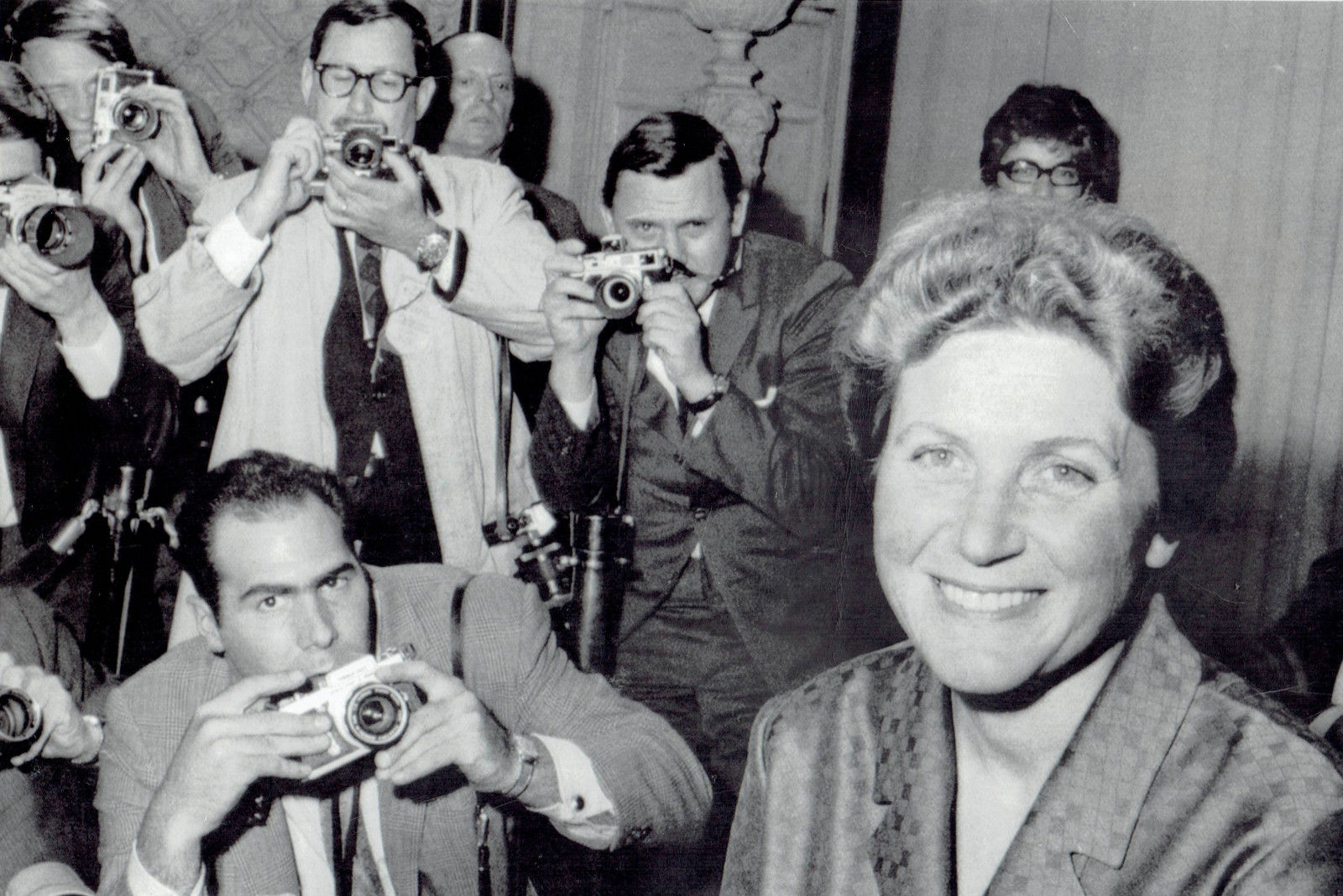22 November 2011 saw the death of Lana Peters in Wisconsin. To those who came into contact with her, she was simply a lonesome frail 85-year-old with a rather strange accent. But she was, in fact, once known by the name of Svetlana Stalin and she was the daughter of Joseph Stalin.
 Peters’ arrival in the US in 1967 (pictured) gave the West a huge propaganda coup – the defection of Stalin’s own daughter was the ultimate proof of how terrible life was behind the Iron Curtain. She had even been prepared to leave behind her two adult children, aged 22 and 17, in the Soviet Union.
Peters’ arrival in the US in 1967 (pictured) gave the West a huge propaganda coup – the defection of Stalin’s own daughter was the ultimate proof of how terrible life was behind the Iron Curtain. She had even been prepared to leave behind her two adult children, aged 22 and 17, in the Soviet Union.
‘I have come here to seek self-expression’
In her first US press conference, in 1967, she acknowledged the father’s monstrous rule but insisted that the blame for the murder of millions of Soviet citizens could not be laid purely on one man – it was the regime and its ideology. ‘I have come here to seek the self-expression that has been denied me for so long in Russia,’ she said. Shortly afterwards, she wrote Twenty Letters To A Friend, which went on to become a bestseller. A follow-up autobiography, Only One Year, sold equally well. With time she became more critical of her past – she publicly burnt her Soviet passport and accused her father of being a ‘moral and spiritual monster’.
In 1970, she married Wes Peters. Peters’ first wife had died in a car crash. She was also called Svetlana and her mother, the widow of the architect, Frank Lloyd Wright, saw in Alliluyeva a divine substitution for her deceased daughter. Under her urging, her new Svetlana and Peters married. They had one child, Olga, and although fond of each other, Svetlana Peters felt too suffocated by her husband’s former mother-in-law’s domineering presence and the marriage ended within three years.
Back in the USSR Continue reading
 Having been devoted to the
Having been devoted to the  At the age of sixteen, she joined an anarchist group based in Kiev, was given the name Fanny Kaplan, sometimes Dora Kaplan, and charged with assassinating the city’s governor. But the bomb she was preparing detonated in her room, almost blinding her. She was arrested and, had she not been so young (she was still under twenty-one), she would have faced the death penalty. Instead, she was sentenced to ‘eternal penal servitude’ in Siberia. During her time of forced
At the age of sixteen, she joined an anarchist group based in Kiev, was given the name Fanny Kaplan, sometimes Dora Kaplan, and charged with assassinating the city’s governor. But the bomb she was preparing detonated in her room, almost blinding her. She was arrested and, had she not been so young (she was still under twenty-one), she would have faced the death penalty. Instead, she was sentenced to ‘eternal penal servitude’ in Siberia. During her time of forced  At the time Hitler had taken upon himself the responsibility of looking after his 21-year-old niece,
At the time Hitler had taken upon himself the responsibility of looking after his 21-year-old niece,  Ekaterina Dzhugashvili, known as Keke,
Ekaterina Dzhugashvili, known as Keke,  Rupert Colley
Rupert Colley But whereas Anne’s diary is a carefully kept journal over a period of two years, Tanya’s was little more than a few scribbled lines over six sheets of notepaper.
But whereas Anne’s diary is a carefully kept journal over a period of two years, Tanya’s was little more than a few scribbled lines over six sheets of notepaper. On 14 December 1861, Albert, the Prince Consort, died. He was only 42. His unexpected death plunged Queen Victoria into grief so overwhelming that it endured for the rest of her life. Her pain was shared by the nation in an outpouring of angst that would not be seen again until the death, 136 years later, of Princess Diana. But after a while, the public and politicians alike began to ask whether the Queen’s period of mourning would ever end.
On 14 December 1861, Albert, the Prince Consort, died. He was only 42. His unexpected death plunged Queen Victoria into grief so overwhelming that it endured for the rest of her life. Her pain was shared by the nation in an outpouring of angst that would not be seen again until the death, 136 years later, of Princess Diana. But after a while, the public and politicians alike began to ask whether the Queen’s period of mourning would ever end. Together they had a son,
Together they had a son,  Following the German occupation of Brussels, Cavell refused the German offer of safe conduct into neutral Netherlands. She continued her work and in the process hid
Following the German occupation of Brussels, Cavell refused the German offer of safe conduct into neutral Netherlands. She continued her work and in the process hid  Mussolini ordered the destruction of the marriage records between him and his first wife, and stopped paying her maintenance, as previously ordered by the courts.
Mussolini ordered the destruction of the marriage records between him and his first wife, and stopped paying her maintenance, as previously ordered by the courts.